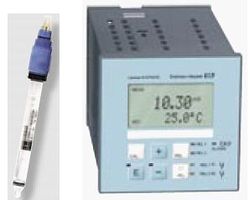PH sensors
Back to Instruments and sensors to measure environmental parameters
General Description
pH measurements are predominantly conducted with pH-sensitive glass electrodes, which have, in general, proven satisfactory in measurements of pH. However, the behaviour of pH-sensitive glass electrodes often falls short of what precision is required.
Even with the most careful treatment, the potential of cells containing glass electrodes often drifts slowly with time after such cells were placed in a new solution. Drift of cell potentials is an especially severe problem in investigations dependent on precise observation of small pH differences. Measurements involving cells with liquid junctions are subject to further uncertainties due to the dependence of liquid junction potentials upon medium concentration and composition and due to pressure changes in the system.
Ideally, the change in liquid junction potential (residual liquid junction potential) between test solution and standardizing buffer should be small or at least highly reproducible. In practice, systematic errors between many measurements suggest that the reproducibility of the residual liquid junction potential is often poor and that residual liquid junction potentials are dependent on the construction and/or history of the liquid junctions used in various investigations. Since pH fluctuations in marine waters are very small, an absolute accuracy of less than 0.1 pH units and a resolution of at least 0.01 pH units is required. For an assessment of the CO2/CO3 systems even a higher accuracy is necessary.
Description of the Sensor
One example is a standard pH Glass Electrode, Endress & Hauser Orbisint CPS 11 together with an electronic unit Liquisys M CPM 223. The electrode is fitted with a PTFE diaphragm, is filled with gel and contains an integrated Pt100 temperature sensor for temperature compensation. It is relatively stable against pressure fluctuations within the system. A photo of the system is shown in Fig. 1.
Calibration
For calibration, the standard procedure is applied, using two buffer solutions with pH=7±0.02 and pH=9±0.02 (Titrisol from Merck) which can be traced to SRM (NIST) and PTB (Germany). Temperature corrections of the buffer solution as given by the manufacturer have to be applied.
See also
- Instruments and sensors to measure environmental parameters
- Ships of opportunity and ferries as instrument carriers
Please note that others may also have edited the contents of this article.
|
